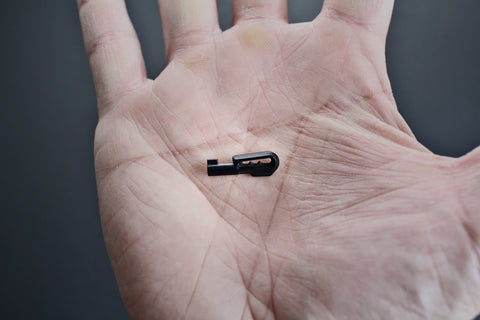Basic Escape & Evasion Methods
A pair of swing cuffs can easily be placed with one hand with a little practice, but handcuffs still need to be placed properly to avoid tampering or escape. Handcuffs placed in front make it much easier to attempt to pick the lock or open them with a universal handcuff key. If you are handcuffed unlawfully, you need to be aware of the following methods of escape.

Hand Positioning
Escaping from handcuffs is very difficult if your hands are behind your back whether you’re using a handcuff key or another means of escape, so do everything possible to ensure that your hands are in front of you. If your captor insists that your hands be behind you, try the following maneuver:
Sit or lie down and fold your legs and feet as close to your body as possible.
Pull your hands down, under your feet, and up to the front of your body. You’ll be in a better position to perform this maneuver if you keep your body flexible and in good shape.
Practice this regularly if you are in a line of work or often find yourself in situations where being unlawfully detained is a threat.
Once your hands are in the front, produce your handcuff key (if you keep it on your back belt loop, you’ll want to grab it while your hands are still behind your back). Insert the key as far as you can into the keyhole. With a firm grip turn the key clockwise, just far enough to disengage the locking mechanism.
Pick the Lock
Because the ratchet & pawl mechanism of most modern handcuffs is simple by necessity, picking a handcuff lock is a pretty simple maneuver. This doesn’t mean you don’t need to practice, a lot. In a tense situation you’ll largely be relying on muscle memory.
Most handcuffs can be unlocked with a single universal handcuff key. Because most types of cuffs can be unlocked with the same key, they can also be picked in much the same way. All you need is a very thin length of wire, and patience.
Keep in mind that this will be much easier if your hands are in front of you. If you are using a bobby pin, straighten it and remove the rubber cap on the end. If using a paperclip, straighten it. It’s wise to keep a prepared bobby pin or other length of wire on your person so you’re not fumbling with getting it ready in the moment.
Bend the end into roughly a 90 degree angle- the easiest way to do this is by inserting the pin or clip halfway into the upper portion of the lock and bending it. This will allow you to wiggle the wire into the lock and apply tension in the appropriate place.
Insert the newly-bent pick into the upper portion of the lock, the curved portion of the pick heading toward the center of the cuffs. Apply enough tension to release the lock. The wire is mimicking a handcuff key pressing against the locking mechanism.
Shimming
A shim is any small, flat piece of metal about the width of a credit card and narrow enough to fit into the locking mechanism. You can purchase pre-made shims that look very similar to a handcuff key, or even create one from a length of cut soda can. Insert the shim in between the locking mechanism and the teeth. Push on the shim and tighten the cuff a single notch. The cuff should unclick. (This method will not work if the cuffs are double locked.)
Preferred Method: Use a universal handcuff key

The surest method of escaping handcuffs is with a universal handcuff key. Using a handcuff key removes the stress and guesswork of trying to use a shim or pick the lock with wire. You’ll want a handcuff key with an easily-concealable design- a key you can clip onto your clothing or gear is ideal. A tiny inconspicuous handcuff key is a valuable addition to any survival toolkit.

